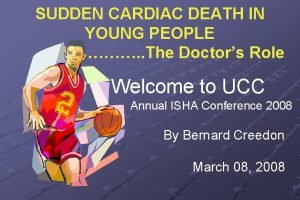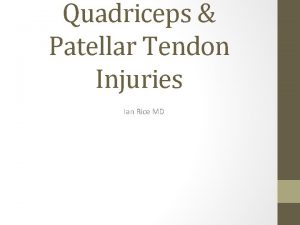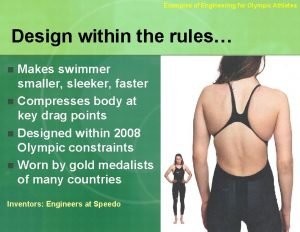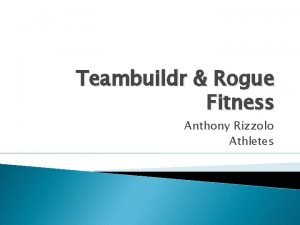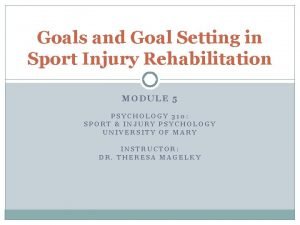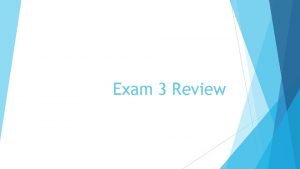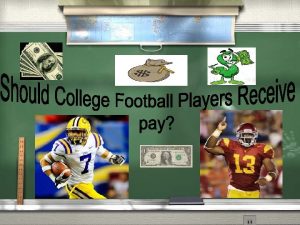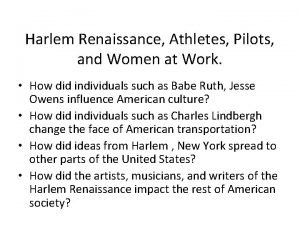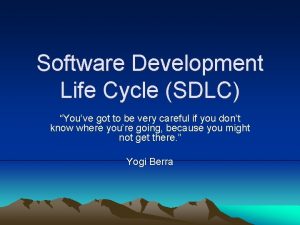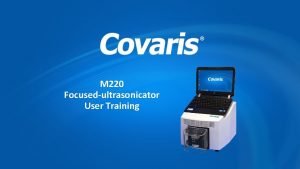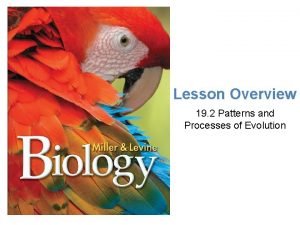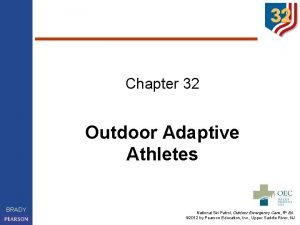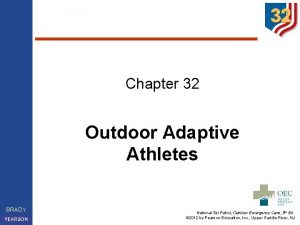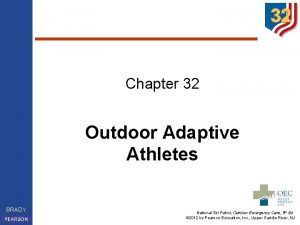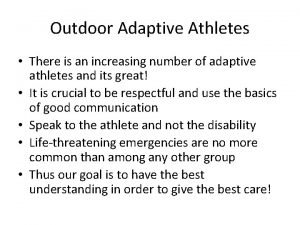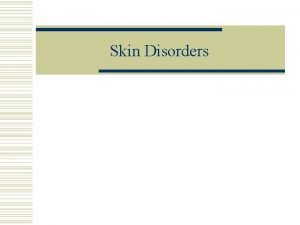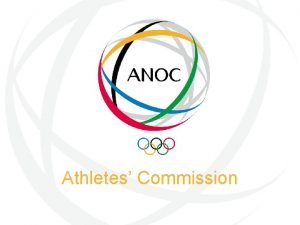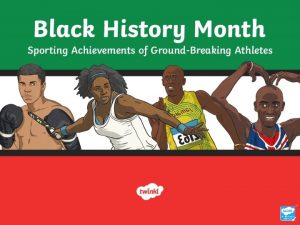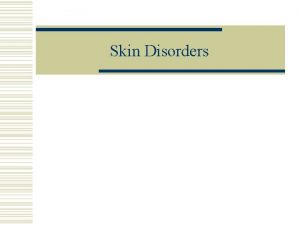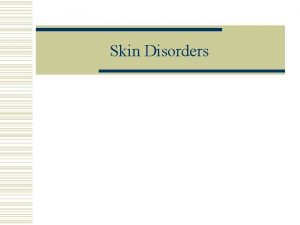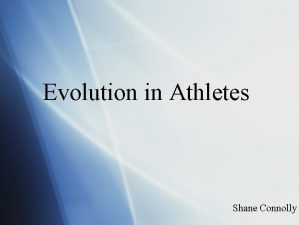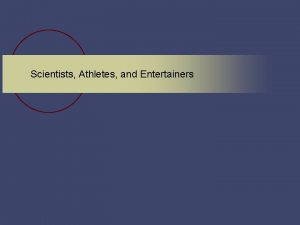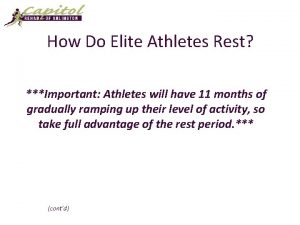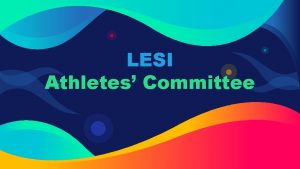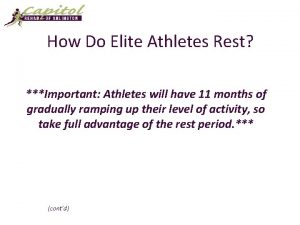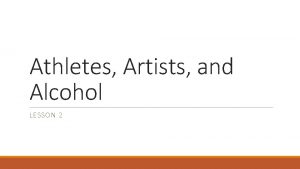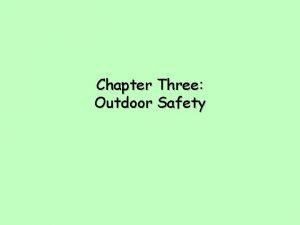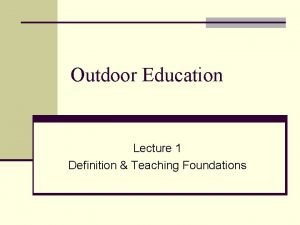Chapter 31 Outdoor Adaptive Athletes Chapter 31 Outdoor





















- Slides: 21

Chapter 31 Outdoor Adaptive Athletes

Chapter 31: Outdoor Adaptive Athletes Objectives • Determine special needs of patients who are mentally challenged. • Determine special needs of patients who are physically challenged. • Demonstrate the special care needs required when treating adaptive patients. 2

Chapter 31: Outdoor Adaptive Athletes Adaptive Populations • In 1990, the ADA opened frontiers for participation. • Different terms are used; the NSP has adopted “adaptive athlete. ” • Adaptive athletes have a long and rich history in sports. • Adaptive skiing programs exist at many ski areas in Europe and the U. S. 3

Chapter 31: Outdoor Adaptive Athletes Mental Challenges • Learning disorders: ADD and/or dyslexia • Mental retardation: Down syndrome • Autism: developmental neurologic disorder • Cognitive disability from a prior brain injury • Psychological disorder: psychosis, manic-depressive (bipolar) 4

Chapter 31: Outdoor Adaptive Athletes Mentally Challenged Patients • Assessment can be challenging. • Supervising adult or caregiver can help communicate. • Use a gentle, calm, caring approach. • Determine level of communication and level or interaction. • Determine if an underlying condition is cause of behavior or if an injury is the cause. 5

Chapter 31: Outdoor Adaptive Athletes Physical Challenges • • • Amputations, ataxia, cerebral palsy Deafness, epilepsy, multiple sclerosis Muscular dystrophy, spina bifida Postpolio syndrome, stroke Spinal cord and/or brain injuries Blindness or other visual challenges 6

Chapter 31: Outdoor Adaptive Athletes Amputee Patients • Amputations can be traumatic, surgical, or a person can be born missing a limb. • Amputation at a joint is a disarticulation. • Prosthesis (artificial limb) may be worn. • Specialized equipment such as outriggers and “buckets” are often used with regular skis. 7

Chapter 31: Outdoor Adaptive Athletes Adaptive Snowsports Terms (1 of 2) • Outrigger: forearm crutch with short ski built onto the bottom • Three tracker: A skier with one ski and two outriggers • Four tracker: A skier with two skis and two outriggers 8

Chapter 31: Outdoor Adaptive Athletes Adaptive Snowsports Terms (2 of 2) • Mono-skier: A skier in a seat or “bucket” mounted to a single ski • Bi-skier: A skier in a seat or “bucket” mounted to a pair or skis. Both use outriggers. 9

Chapter 31: Outdoor Adaptive Athletes Treating Amputee Athletes • Gently remove prosthesis from an injured limb. • Extricate patient from equipment. • Traction for a femur fracture may not be possible due to distal amputation. • Outriggers can cause upper extremity injuries. • Let patient comfort guide treatment. 10

Chapter 31: Outdoor Adaptive Athletes Cerebral Palsy (CP) Patients • CP is a result of a brain injury before, during, or shortly after birth. • Three syndromes: – Spastic—constant muscle contraction – Athetoid—slow, writhing movements – Dystonic—extreme muscle rigidity • Usual fracture treatments may not work. • Again, let comfort guide treatment. 11

Chapter 31: Outdoor Adaptive Athletes Multiple Sclerosis (MS) Patients • Neurologic condition that effects stamina, balance, vision, and cranial nerves. • Disease may have periods of remission and exacerbation. • Individuals process information slower and may take longer to respond. 12

Chapter 31: Outdoor Adaptive Athletes Muscular Dystrophy (MD) Patients • • • Progressive muscle atrophy Easily fatigued Joints are hypermobile. Usually sit skiers Gentle approach to prevent further injuries 13

Chapter 31: Outdoor Adaptive Athletes Postpolio Syndrome Patients • Usually have a “wasted” or atrophied limb • The limb can have some or no function. • Be aware of pre-existing CMS dysfunction. • Protect any affected limb. 14

Chapter 31: Outdoor Adaptive Athletes Spina Bifida (SB) Patients • Mono- and bi-skiers mostly. • Spinal compromise only below congenital anomaly • SB patients may have a CSF shunt— blockage may cause mental status change. • They may also have an extreme latex allergy. Use non-latex gloves. 15

Chapter 31: Outdoor Adaptive Athletes Spinal Cord Injury Patients (1 of 2) • Quadriplegia—injury to cervical spine • Paraplegia—injury to thoracic or lumbar spine • Sit skiers (mono or bi) if injury was lower than T 5 • May exhibit autonomic dysreflexia (AD) 1. Can be a life threatening due to hypertension 2. Eliminating stimuli will usually correct 16

Chapter 31: Outdoor Adaptive Athletes Spinal Cord Injury Patients (2 of 2) • Lack normal sensation and movement below original injury site • Unknown injuries can occur easily: – Frostbite, fractures, and soft-tissue injuries such as lacerations, abrasions – Assess insensate extremities carefully. – Guard against further injury. • Upper extremity injuries occur due to outrigger use. 17

Chapter 31: Outdoor Adaptive Athletes Stroke and Brain Trauma Patients • Disability is related to the amount and site of prior injury. • Some may exhibit behavioral or psychological changes as well. • Patients may exhibit aphasia. • Watch for seizures, and treat them appropriately. 18

Chapter 31: Outdoor Adaptive Athletes Visually and Hearing Impaired Patients • Participation is increasing. • Visually impaired patients have a guide. • Remember to speak to patient while treating. • Gain the attention of the hearing impaired patient and speak directly to him or her. 19

Chapter 31: Outdoor Adaptive Athletes Other Treatment Concerns • Ostomy bags collect feces and urine. • Rescuers should avoid exerting pressure on these appliances. • Watch for blood in collection bags; this could indicate trauma. 20

Chapter 31: Outdoor Adaptive Athletes Lift Evacuation and Transport • Sit-skiers should always have a threepoint leash that can be used for evacuation. • Visually impaired skiers should be lowered before their guide. 21
 Athletes vs non athletes academic performance
Athletes vs non athletes academic performance Why should teen athletes avoid performance enhancers?
Why should teen athletes avoid performance enhancers? Volleyball 6 word memoirs
Volleyball 6 word memoirs All athletes have an innate preference
All athletes have an innate preference Athletes suddenly dying
Athletes suddenly dying Famous athletes with osgood schlatters disease
Famous athletes with osgood schlatters disease Athletes body engineers
Athletes body engineers Rogue fitness athletes
Rogue fitness athletes Kingdom fungi examples
Kingdom fungi examples Importance of goal setting for athletes
Importance of goal setting for athletes The presence of spectators helps young athletes
The presence of spectators helps young athletes Should college athletes be paid thesis statement
Should college athletes be paid thesis statement Harlem renaissance athletes
Harlem renaissance athletes Sex verification testing of athletes worksheet
Sex verification testing of athletes worksheet Becker
Becker Adaptive maintenance in software engineering
Adaptive maintenance in software engineering Adaptive maintenance in software engineering
Adaptive maintenance in software engineering Excellent choice for systems requiring high reliability
Excellent choice for systems requiring high reliability Situational leadership vs adaptive leadership
Situational leadership vs adaptive leadership Linda r greene
Linda r greene Afa grade water
Afa grade water Adaptive radiation
Adaptive radiation




